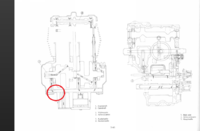Yes, those are the diagrams I'm looking at. I agree, that is the area where I was thinking as well. At about the 5 o'clock position from where you marked. It is a strange design that the engineers at Yamaha came up with. The center section under that cover is pressurized oil feeding from the main oil galley to the crankshaft and the transmission main axle. The outer area is the oil sump as best as I can tell. I've installed my oil temp sender in the outer area of the cover. It is thin enough profile that I'm not worried about it being installed there. Hose fittings would be a different story. Without a skid plate or similar protection, it would be too great a risk of damage.
Another possible spot would be either the right or left engine covers, as the main oil galley connects to them. That would put the fittings and hoses on the side of the engine, where they would still be exposed, but less likely to be damaged. The screws for the covers would also make for handy mounting points for rubber insulated hose mounting clamps.





 I did mention oil cooler in my post so there that's been cleared up.I simply brought that up because by looking at a Harley engine which has an external oil cooler it could be used as an example for a mock up.
I did mention oil cooler in my post so there that's been cleared up.I simply brought that up because by looking at a Harley engine which has an external oil cooler it could be used as an example for a mock up.